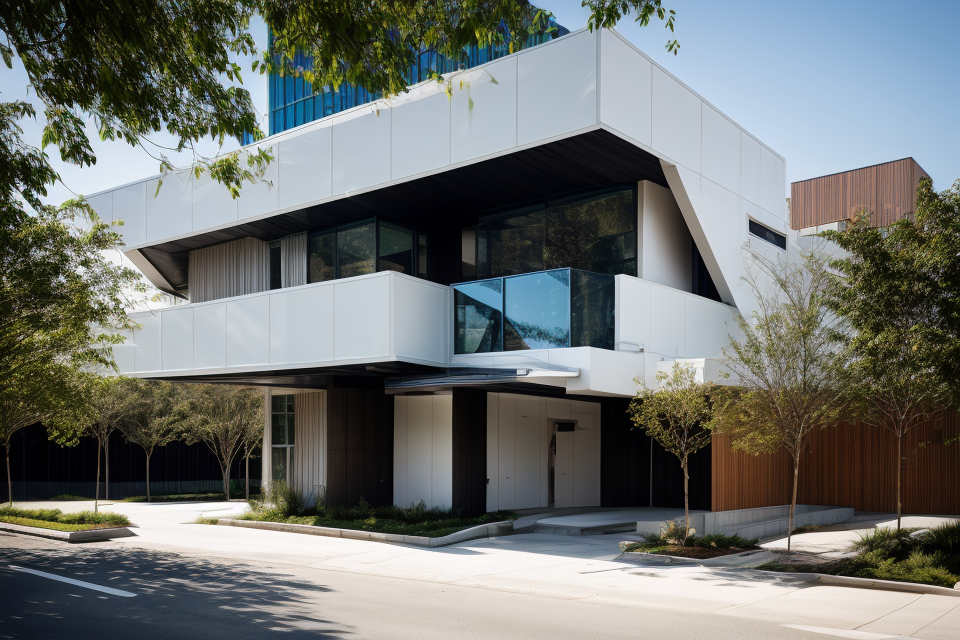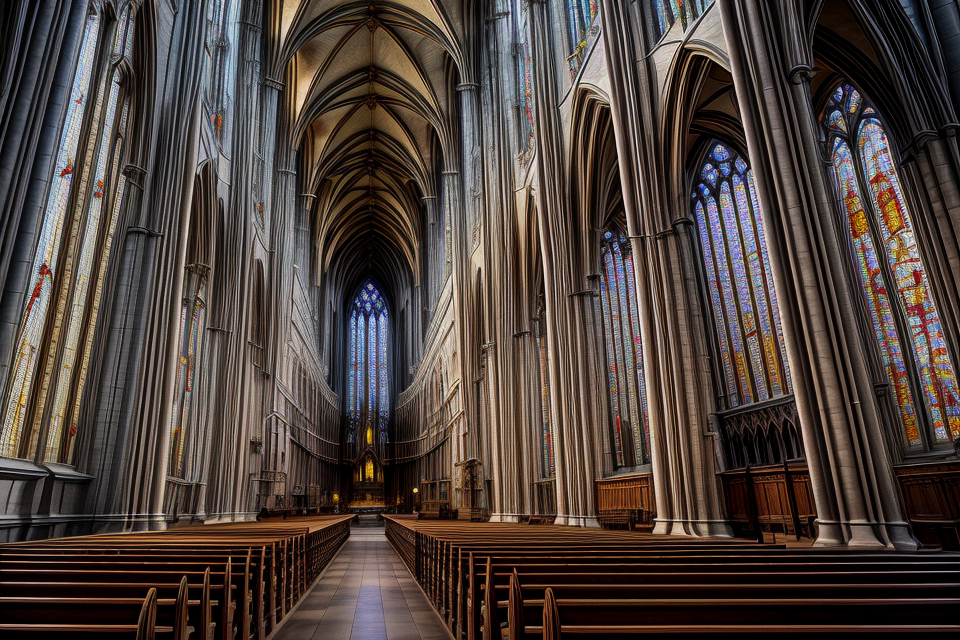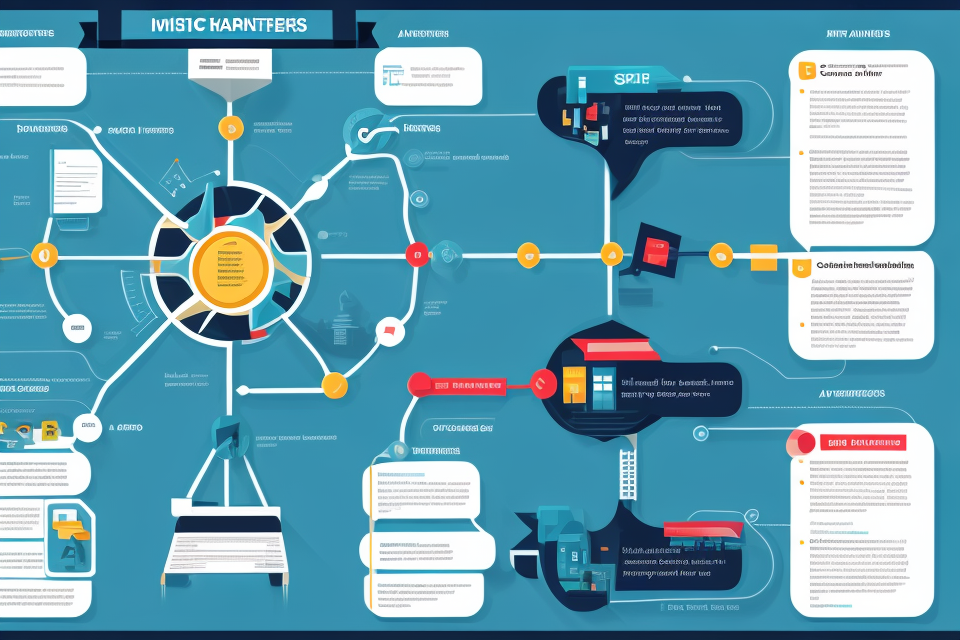Contemporary architecture is a fascinating and ever-evolving field that is constantly pushing the boundaries of design and technology. With so many different styles and approaches, it can be challenging to keep up with the latest trends. In this article, we will explore the three most prominent styles in contemporary architecture and their unique characteristics. From minimalist and sleek designs to bold and expressive statements, these styles are shaping the urban landscape and leaving a lasting impact on our built environment. Whether you’re an architect, designer, or simply a curious observer, this article will provide a comprehensive overview of the most exciting styles in contemporary architecture today.
Defining Contemporary Architecture
Key Characteristics
- Flexibility: One of the key characteristics of contemporary architecture is its ability to adapt to changing needs and circumstances. This means that buildings are designed to be flexible and versatile, with the ability to be easily reconfigured or modified over time. This is particularly important in today’s fast-paced world, where technological advancements and changing social norms can quickly render a building obsolete.
- Sustainability: Another important characteristic of contemporary architecture is its focus on sustainability. This means that buildings are designed to minimize their impact on the environment, by using energy and resources efficiently, reducing waste, and incorporating features such as solar panels and green roofs. This not only helps to reduce the building’s carbon footprint, but also contributes to the overall health and well-being of its occupants.
- Technological advancements: The third key characteristic of contemporary architecture is its embrace of technological advancements. This means that buildings are designed to incorporate the latest technologies, such as smart sensors, automation systems, and digital interfaces, to enhance their functionality and performance. This not only improves the user experience, but also allows buildings to be more efficient and cost-effective to operate and maintain.
Influences
Contemporary architecture is greatly influenced by a variety of factors, including art and design, cultural and social changes, and historical architectural styles. These influences can be seen in the way that contemporary architects approach the design of buildings and structures, and in the styles and forms that they create.
Art and Design
One of the key influences on contemporary architecture is art and design. Architects are often inspired by the work of artists and designers, and they incorporate elements of art and design into their buildings and structures. This can include the use of color, form, and texture, as well as the incorporation of sculptural elements and other artistic features.
Cultural and Social Changes
Another important influence on contemporary architecture is cultural and social changes. As society evolves, so too does the way that we build and live in our environments. Contemporary architects are often driven by a desire to reflect these changes in their work, and to create buildings and structures that are more reflective of the world around us.
Historical Architectural Styles
Finally, historical architectural styles also play a role in shaping contemporary architecture. Architects may draw inspiration from the past, incorporating elements of traditional styles into their work or reinterpreting these styles in new and innovative ways. This can lead to the creation of buildings and structures that are both modern and timeless, drawing on the best of the past to create something truly unique and innovative.
The Three Styles of Contemporary Architecture
Style 1: Minimalism
Features
- Simplicity
- Functionality
- Monochromatic color schemes
Minimalism is a style of contemporary architecture that emphasizes simplicity and functionality. Buildings that follow this style often have clean lines, a lack of decorative elements, and a focus on practicality. Minimalist architecture seeks to strip away unnecessary features, leaving only the most essential elements in place. This style is often characterized by its use of monochromatic color schemes, which can help to create a sense of calm and tranquility.
Examples
- The Farnsworth House by Ludwig Mies van der Rohe
- The Seagram Building by Ludwig Mies van der Rohe and Philip Johnson
Two notable examples of minimalist architecture are the Farnsworth House by Ludwig Mies van der Rohe and the Seagram Building by Ludwig Mies van der Rohe and Philip Johnson. The Farnsworth House is a single-story building that consists of a series of identical rectangular rooms arranged in a row. The building’s exterior is made of glass and steel, and the interior is adorned with simple, modern furniture. The Seagram Building, on the other hand, is a skyscraper that features a distinctive black facade made of bronze-tinted glass. The building’s design is characterized by its clean lines and simple geometry, and it has become an iconic example of minimalist architecture.
Style 2: Brutalism
Brutalism is a style of contemporary architecture that is characterized by its raw, exposed concrete and monolithic structures. It focuses on functionality over aesthetics, which can create a sense of austerity and severity in its buildings.
- Boston City Hall by Kallmann McKinnell & Wood Architects: This building is a prime example of Brutalist architecture. Its raw concrete exterior and large, geometric shape give it a bold and imposing presence in the city.
- The Barbican Centre by Chamberlin, Powell and Bon: This cultural center in London is one of the largest examples of Brutalist architecture in the world. Its raw concrete exterior and brutalist design make it a striking and memorable landmark in the city.
Style 3: Biophilic Design
Biophilic design is a style of contemporary architecture that focuses on creating buildings that connect people with nature. This style incorporates the use of natural materials and green spaces to promote a sense of well-being and harmony with the environment.
Connection to nature
Biophilic design emphasizes the importance of connecting people with nature, as it is believed that this connection has a positive impact on physical and mental health. Buildings that incorporate biophilic design features, such as natural light, green spaces, and views of nature, have been shown to reduce stress, improve productivity, and enhance overall well-being.
Use of natural materials
Biophilic design also encourages the use of natural materials in building construction. These materials can include wood, stone, and other materials that are sourced from the environment. The use of natural materials can help to create a sense of warmth and authenticity in a building, while also reducing the environmental impact of construction and operation.
Incorporation of green spaces
In addition to using natural materials, biophilic design also prioritizes the incorporation of green spaces into building design. This can include rooftop gardens, vertical gardens, and other features that bring nature into the built environment. Green spaces have been shown to have a positive impact on mental health, and can also help to reduce energy consumption and improve air quality.
- The Living Building by Willis and Associates
The Living Building, designed by Willis and Associates, is an example of biophilic design in action. The building is designed to be self-sustaining, with features such as a green roof, solar panels, and a rainwater collection system. The interior of the building is also designed to promote a connection with nature, with natural light and views of the surrounding landscape.
- The Green Tower by ENSOS
The Green Tower, designed by ENSOS, is another example of biophilic design. The building is designed to incorporate green spaces into its design, with terraces and balconies that provide opportunities for residents to connect with nature. The building also uses natural materials, such as wood and stone, to create a warm and inviting atmosphere.
Overall, biophilic design is a style of contemporary architecture that prioritizes the connection between people and nature. By incorporating natural materials and green spaces into building design, biophilic architecture aims to promote well-being, reduce stress, and enhance the overall quality of life for building occupants.
Comparison of the Three Styles
Similarities
- Focus on functionality: All three styles prioritize functionality over aesthetics, emphasizing the importance of design that serves a purpose.
- Use of innovative materials and technology: Each style utilizes cutting-edge materials and technologies to achieve their goals, pushing the boundaries of what is possible in architecture.
- Responsiveness to the environment: Whether through the integration of green spaces or the consideration of environmental factors, each style demonstrates a commitment to sustainability and the preservation of natural resources.
Differences
- Minimalism: This style emphasizes simplicity and monochromatic color schemes, focusing on the elimination of unnecessary elements and the creation of clean, uncluttered spaces.
- Brutalism: Brutalism is characterized by its use of raw, exposed concrete and monolithic structures, often creating a sense of permanence and solidity.
- Biophilic Design: Incorporating green spaces and a connection to nature, biophilic design seeks to bring the outside in and create a sense of harmony between the built environment and the natural world.
The Future of Contemporary Architecture
Emerging Trends
Digital design and fabrication
One of the emerging trends in contemporary architecture is the increased use of digital design and fabrication tools. These tools allow architects to create complex geometries and forms that would be difficult or impossible to achieve using traditional drafting methods. Digital design also allows for greater collaboration between architects, engineers, and other stakeholders, as well as the ability to quickly and easily make changes to designs.
Adaptive reuse of existing buildings
Another trend in contemporary architecture is the adaptive reuse of existing buildings. This involves taking a building that is no longer being used for its original purpose and repurposing it for a new use. This can be a more sustainable and cost-effective way to create new spaces, as it reduces the need for new construction and can preserve historic or culturally significant buildings.
Integration of renewable energy sources
Finally, there is a growing trend towards the integration of renewable energy sources into contemporary architecture. This can include features such as solar panels, wind turbines, and green roofs, which can help to reduce a building’s energy consumption and carbon footprint. In addition, the use of renewable energy sources can often provide cost savings over time, making them an attractive option for building owners and developers.
The Impact of Sustainability
- Environmental concerns
- Climate change and global warming
- Depletion of natural resources
- Biodiversity loss
- Energy efficiency
- Reducing energy consumption
- Harnessing renewable energy sources
- Improving building performance
- Social and economic considerations
- Affordable housing
- Community development
- Economic growth and job creation
In recent years, sustainability has become a significant driving force in contemporary architecture. As the world faces environmental challenges such as climate change, natural resource depletion, and biodiversity loss, architects and designers are increasingly focusing on creating buildings that are environmentally friendly and sustainable. This includes designing buildings that use energy efficiently, harness renewable energy sources, and reduce their carbon footprint.
In addition to environmental concerns, sustainability in contemporary architecture also considers social and economic factors. Architects are now designing buildings that address issues such as affordable housing, community development, and economic growth. These considerations are crucial in ensuring that contemporary architecture not only benefits the environment but also improves the quality of life for people.
As the world continues to grapple with environmental challenges, the impact of sustainability on contemporary architecture is likely to grow. Architects and designers will need to find innovative ways to create buildings that are environmentally friendly, energy-efficient, and socially responsible. By doing so, they can help shape a more sustainable future for the built environment.
The Role of Technology
- Virtual reality and augmented reality
Virtual reality (VR) and augmented reality (AR) are technologies that have the potential to revolutionize the way we experience and interact with architecture. VR allows users to step inside a virtual space and explore it as if it were real, while AR enhances the real world with digital information. Both technologies can be used to create immersive experiences that can help people better understand and appreciate architecture. - Digital design tools
Digital design tools have transformed the way architects work. Software such as AutoCAD, SketchUp, and Revit allow architects to create, modify, and visualize designs in a digital environment. These tools have made it possible to create complex and detailed designs that would have been impossible to create by hand. They also allow architects to collaborate more easily and to quickly make changes to their designs. - Advanced materials and construction techniques
Advanced materials and construction techniques are changing the way buildings are constructed. New materials such as carbon fiber and 3D-printed concrete offer new possibilities for design and construction. In addition, advances in construction techniques such as prefabrication and modular construction are making it possible to build faster, more efficiently, and with less waste. These advances are making it possible to create buildings that are stronger, lighter, and more sustainable.
FAQs
1. What are the three styles in contemporary architecture?
Contemporary architecture can be broadly categorized into three distinct styles: Modernism, Postmodernism, and Green or Sustainable Architecture.
2. What is Modernism in contemporary architecture?
Modernism is a style of architecture that emerged in the early 20th century and is characterized by clean lines, functional design, and the use of new materials and technologies. It emphasizes simplicity, minimalism, and the removal of ornamentation.
3. What is Postmodernism in contemporary architecture?
Postmodernism is a reaction to Modernism and emerged in the mid-20th century. It is characterized by a return to historical forms and styles, as well as the use of bold colors, decorative elements, and irregular shapes. Postmodern architecture often incorporates a mix of different styles and features a sense of playfulness and irony.
4. What is Green or Sustainable Architecture in contemporary architecture?
Green or Sustainable Architecture is a style of architecture that prioritizes environmental sustainability and seeks to minimize the negative impact of buildings on the environment. It incorporates features such as energy-efficient design, the use of renewable energy sources, and the use of sustainable materials. Green architecture is designed to be environmentally responsible and resource-efficient.
5. How does contemporary architecture reflect changes in society and culture?
Contemporary architecture reflects changes in society and culture through its incorporation of new technologies, materials, and design approaches. It also reflects the values and priorities of society, such as a growing concern for environmental sustainability and a focus on creating livable, inclusive communities.
6. What are some examples of contemporary architecture around the world?
There are many examples of contemporary architecture around the world, including the Burj Khalifa in Dubai, the Guggenheim Museum in Bilbao, Spain, and the National Museum of China in Beijing. Other notable examples include the Museum of Modern Art in New York City, the Louvre Abu Dhabi, and the Sydney Opera House.
7. How does contemporary architecture impact society and culture?
Contemporary architecture has a significant impact on society and culture by shaping the built environment and influencing the way people live, work, and interact with their surroundings. It can also reflect and reinforce cultural values and social norms, and it can inspire new ways of thinking and innovation.
8. What are some challenges facing contemporary architecture?
Some challenges facing contemporary architecture include sustainability, affordability, and accessibility. There is also a need for innovation and creativity in addressing the complex issues facing society and the environment. Additionally, there is a need for more diverse and inclusive representation in the field of architecture.



